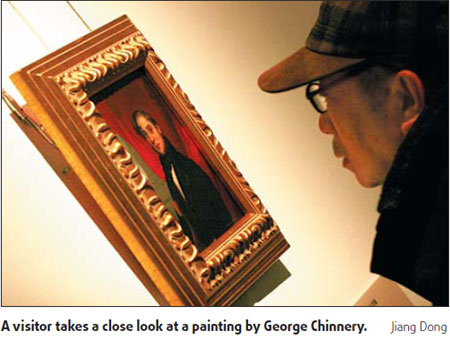
British artist George Chinnery (1774-1852) traveled around the world and led a life of extravagance and recklessness.
Heavily indebted, the opium addict and son of a member of the British East India Company, fled from India to Macao in 1825.
Chinnery may have never expected to remain in Macao till his death in 1852 and is remembered for introducing Western oil and watercolor art to China.
Some of his signature works and those by his Chinese disciples are part of an ongoing art show at the National Art Museum of China in Beijing.
The grand exhibition, coinciding with the 10th anniversary of Macao's return to China, features more than 300 oils and watercolors as also contemporary paintings by artists who lived or stayed in Macao from the mid-19th century to the present, according to Chan Hou Seng, director of the Macao Museum of Art, a key organizer of the event.
"Macao served as a melting pot of Asian and Western art and culture in the 19th century," says Chan.
"The exhibition offers a glimpse into the dramatic changes in Macao's fine arts."
Arranged in chronological order, the exhibition is divided into four parts, namely the historical paintings of the 19th century, watercolor paintings, contemporary art and four huge paintings jointly created by artists from the mainland to celebrate Macao's handover to China.
The first part exhibits 60 rarely seen works of art, mostly by British artist George Chinnery, his student Thomas Watson (1815-80), his Chinese student Lam Qua, French artist Auguste Borget (1808-77) and Macanese painter Marciano Antonio Baptista (1826-96).
"Inspired by the unique look of Macao which mixes Chinese and European influences, these artists churned out the first works depicting the landscapes and local life of Macao more than 100 years ago," notes Chan.
"Their works carry rich information about Macao's local culture, landscapes, streets, commercial activities, and provide the Western world with vivid images of Macao, Canton (Guangdong) and other coastal areas of China."
More importantly, "these foreign artists, George Chinnery in particular, brought new art genres, such as oil and watercolor that are different from Chinese folk art or the orthodox ink painting", says Fan Di'an, dean of the National Art Museum of China.
Chinnery exhibited at the Royal Academy in London at the age of 17, after which he fled to India to escape his wife. When she followed him there, he moved to Macao, where he spent most of the early 19th century, documenting the Portuguese colony of Macao, as well as Hong Kong and other parts of the Far East.
Chinnery's landscapes and portraits are remarkable for the quality of their draftsmanship. He often used them as a reference for subsequent large-scale oil paintings, as samples for his clients looking to commission works, for his pupils to trace and copy, as gifts for his friends and for sale to pay off his debts.
"Chinnery also taught Chinese students oil and watercolor skills. For instance, he exerted a great influence on Lam Qua, one of the best known of the later Chinese oil painters of that period," Chan says.
To give viewers a complete picture of the development of watercolor art in Macao, 119 poetic watercolor works, including several by Chinnery and Russian watercolor master George Smirnoff, are on show.
"Watercolor has become a favorite art form with contemporary artists who want to capture Macao's rich and diverse natural scenes, cultural heritage and social reality," says Chan.
The third part of the exhibition, with 117 exhibits, shows Macao's boom in contemporary art since the early 1980s and 1990s.
"Even as it was subjected to the restrictions of information and environment, Macao's art circles adopted traditional ink and wash, watercolor and oil painting as its main medium until the 1970s," says art critic and curator James Chu.
It was not until the early 1990s when artists from the Chinese mainland, Hong Kong, Portugal, Singapore, Australia and Russia settled in a fully urbanized Macao, and began to draw inspiration from the melding of Oriental and European cultures, that works of compelling and diverse styles were born, he says.
Today's Chinese artists, especially the younger generation, "are not shy to resort to varied art forms like installation, performance, video and electronic media to expound their independent thoughts on society and life".
Also on show is View of Praya Grande, Macao, a rare daguerreotype photo, created by French photographer Alphonse Eugene Jules Itier (1802-77) in 1844.
One of the few daguerreotype photos found in China, it is in the collection of the Macao Museum of Art, donated by the Fok Ying Tung Foundation.
Of all the daguerreotype photos still to be found in the world, only 37 are about Chinese landscapes and 6 of them are about old Macao, according to exhibition curator Ng Fong Chao.
The exhibition runs through March 22.
(China Daily, March 17, 2009)